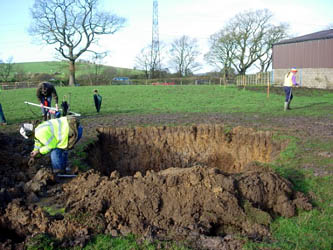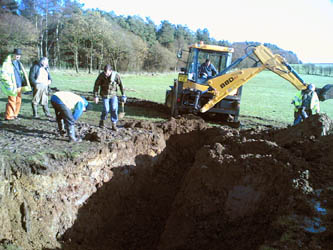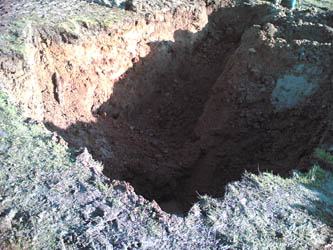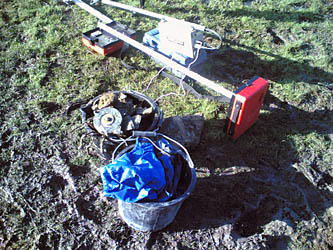 |
Meteor
VT121 - Over Kellett
22nd July 1951 |
 |
Meteor
VT121 - Over Kellett
22nd July 1951 |
Updated on 25.03.2008
As the reader may have noted, our first major excavation of a post-war jet - Attacker WA535 - proved to be a most successful excavation, despite the reservations of some members. However the following account covering our second post-war jet dig shows just how unpredictable this hobby can be!
|
|
Gloster Meteor F4s of 611 Squadron |
| Type | Unit | Base | Duty | Crew | Passengers |
| Meteor F4 | 611 Squadron | Hooton Park | R.O.C. Cooperation Excercise | 1 | - |
No 611 (West Lancashire) Squadron was formed as an Auxiliary Squadron at Speke in 1936, one of a number of such squadrons set up during the inter-war period to ensure a supply of trained pilots in the event of war. 611 certainly played an active part during WWII; providing fighter cover high above the Dunkirk beaches during the evacuation, playing an active role in the Battle of Britain, as well a very active part in the ill-fated Dieppe raid and later, covering the Normandy landings. Disbanded in 1945, the Squadron re-formed in 1946 and was soon based at Woodvale, being initially equipped with Spitfires, but giving way to Meteors in 1951, with the first arriving in April of that year. May and June 1951 saw the squadron's pilots beginning their conversion to the new type, as well as plans being made for a move to Hooton Park, which took place in early July. This was followed by a period of fairly intensive training for 611's pilots on the Meteor, but tragedy struck on the 22nd with the loss of Meteor F4, VT121, an ex 19 Squadron machine which had only just been transferred to 611.
Sunday the 22nd July was set for an All-day co-operation exercise with the Royal Observer Corps, which was initially delayed due to bad weather. Conditions must not have improved as at approx. 10.30 those aircraft that had taken off were recalled, with the exercise being cancelled altogether at 11.00 due to approaching thunderstorms. 27 year old Sgt. T.A.R. Price piloting VT121 was in the vicinity of Carnforth when he received and acknowledged the recall transmission and it seems that he descended through the layered cloud prevalent at that time, in order to pinpoint his position. It is thought that he then entered an area of low cloud and attempted to keep the aircraft's nose down, which resulted in him emerging from this at around 200 feet from the terrain in a diving turn to port with insufficient height to recover and struck the ground.
A local witness recalled hearing the aircraft engine under power, before it appeared briefly "coming down steep and fast", then he heard the crash. Rushing to the scene he met the shaken driver of a passenger vehicle that had been passing on a nearby road, who stated that he had thought the aircraft was going to hit his vehicle. When they reached the scene they found that the plane had been completely destroyed in the impact and numerous fires had been started, by the fuel, mainly in a wood on the far side of the field. Soon some three acres of wood and scrub land was ablaze, but the fires were dealt with by Carnforth Fire Brigade who were soon on the scene - once they had managed to managed to get past cars parked by the many spectators who converged on the scene. The local paper reported that a seven-foot deep crater had been left by the impact and that a five-foot section of wing was the largest remnant of the aircraft. This and the aircraft's wheels appeared to be the only recognisable parts remaining amongst the widely scattered debris. Sgt. T.A.R. Price was buried on 26th July in a private ceremony at St. John's Church, Waterloo, Liverpool, which was attended the squadron's commanding officer and three other airmen.
| Name | Position | Status |
| Sgt. Thomas Arthur Rignold Price | Pilot | K. |
Though we were aware of this incident, it was not until conducting research into the loss of two Seafires locally, that the nearby crash site of VT121 at Over Kellett was brought to our attention. Although a post-war jet, we initially decided that the site at least warranted investigation and recording, not least because the aircraft was on the strength of one of the Lancashire squadrons when it was lost. As access to the site was very easy and marker posts at the edge of the field indicated that an underground pipeline crossed the field, we initially thought that very little would remain at the site. However a distinct crater well away from the pipeline aroused our interest and a metal detector survey soon revealed fragments - particularly in this area and towards the edge of the field and in the wooded copse beyond. In fact larger parts soon became apparent in the wooded area, some entangled in the tree roots, which could not be recovered. At this point it was decided to return with our deep seeking equipment and dependent on the results to arrange an excavation of the site. The survey was duly carried out and both machines gave good readings, with the Forster giving particularly strong signals and indicating three substantial targets at a depth of around six to eight feet.
 |
 |
|
Once the first pieces of wreckage were recovered it became obvious that all was not as anticipated. |
Chasing elusive Magnetometer readings, the hole began to enlarge, but with few finds to show for it. |
After several delays due to factors outside our control the excavation of the site was set for October 2005 and despite a more favorable forecast than throughout the week before, the day certainly did not start off promising as near horizontal rain swept the site and the top two feet of topsoil proved to have soaked up the previous weeks heavy rains like a sponge and was very soft. In fact neither of our 4x4s made it into the field and even the JCB struggled, leaving deep furrows across the field as it maneuvered into position. However we were not to be put off and soon the topsoil was being cleared from the distinct crater and traces of "daz" could be seen in the subsoil below. At first all appeared to be going well and even the weather began to improve! Only a couple of feet down the digger's bucket encountered an apparently solid mass and willing volunteers moved in to assess what had been uncovered and remove any loose artifacts by hand to avoid damage. Instantly recognisable was the oil buffer from a 20mm Hispano cannon - still firmly attached to the back of the gun's breech - but the rest was simply a mass of crumpled metal. Digging around this soon loosened the cannon, which proved to be missing its barrel - though this was fortunately found soon after and the compacted remains were soon removed from the hole. However instead of the expected continuing trail of debris leading down to a main mass of wreckage, the sand below looked ominously clean. We continued to follow the shadow of discoloured sand down, but apart from odd fragments and traces of burning, no more wreckage was found.
 |
 |
|
The darker discoloured sandy soil can clearly be seen centre, finally giving way to natural undisturbed subsoil at approx 6 to 8 feet down. |
Apart from the cannon, a few weights and a crumpled section of the cockpit side, only a couple of buckets full of smaller components were found. |
Moving the digger a suitable distance back to prevent interference, we re-surveyed the area using our Forster magnetometer and found that the substantial central reading had now all but vanished and only a handful of contacts around the main crater now remained. These were systematically excavated, but all were found to be relatively small items: counterbalance weights from the ailerons and rudder and the armoured lower edge / skid from the tail, being the most significant. Having obviously reached the limit of disturbed ground and with no more readings from our detection equipment the excavation was closed down, the hole backfilled and topsoil replaced. Fortunately the weather had by now improved and we set about the task of reinstating the field and filling in the deep tracks left by the retreating JCB.
We concluded that the aircraft must have exploded immediately on contact with the ground and the force of this explosion had somehow dissipated or re-directed the usual forces of momentum that carry wreckage into the ground - the crater we had excavated therefore being due to this blast rather than impact. This appeared to be confirmed by the fact that the parts we had found appeared to have been thrown in loosely and buried in the infill in the centre of the crater - probably as an easy way of disposal rather than having been buried during the crash itself.
Quite why the Forster had given such a substantial reading is a bit of a mystery to us, especially as our Fisher Gemini III had seemed to back up the impression that there were substantial remains buried at this site. Clearly this was not the case, but somehow it seems that the arrangement of the debris, their proximity to the surface and the ground conditions had combined and caused both machines to "over-read" - showing that there is no certainty in this hobby!!!
Mark Gaskell, Gareth Brown, Alan Clark.
This page & all articles on this site Copyright © Nick Wotherspoon 2008